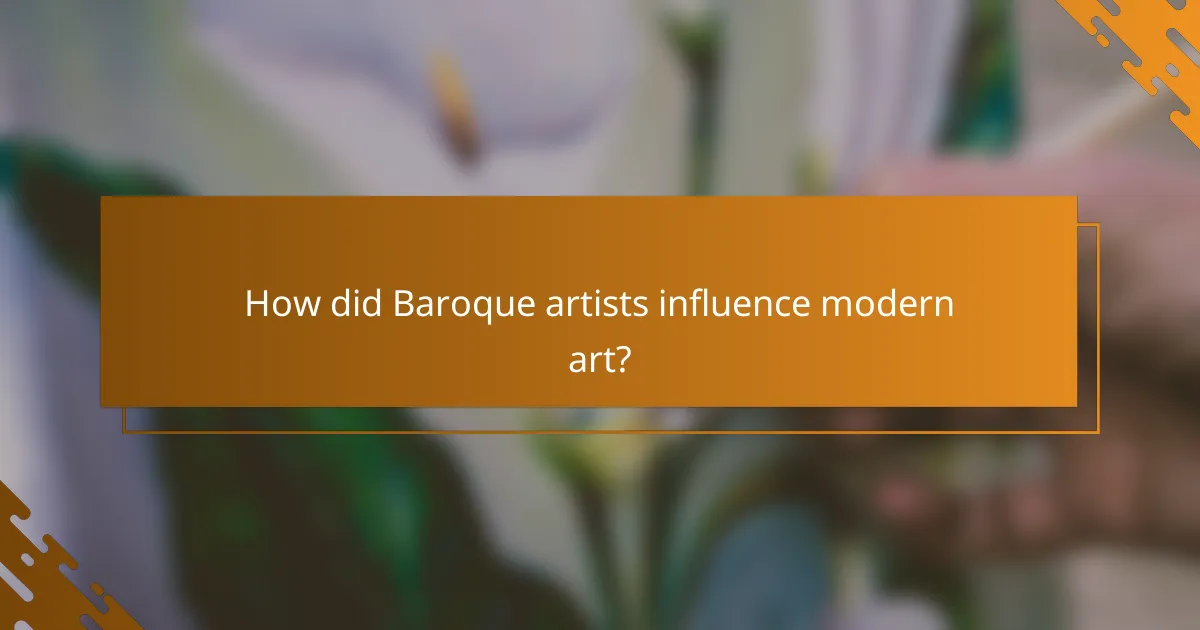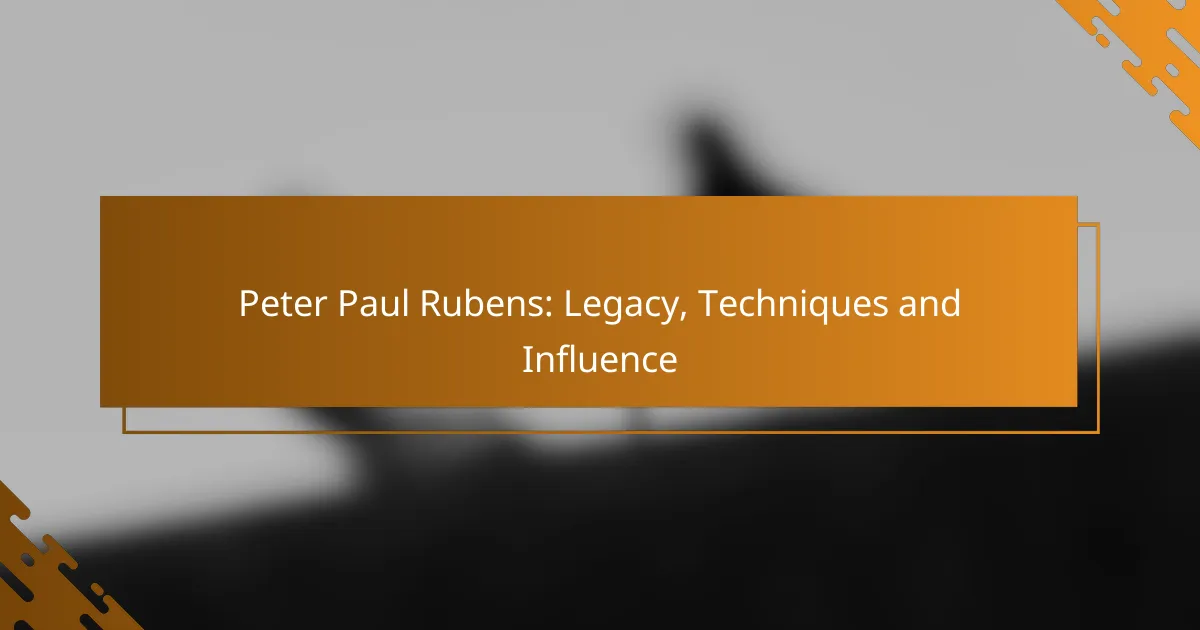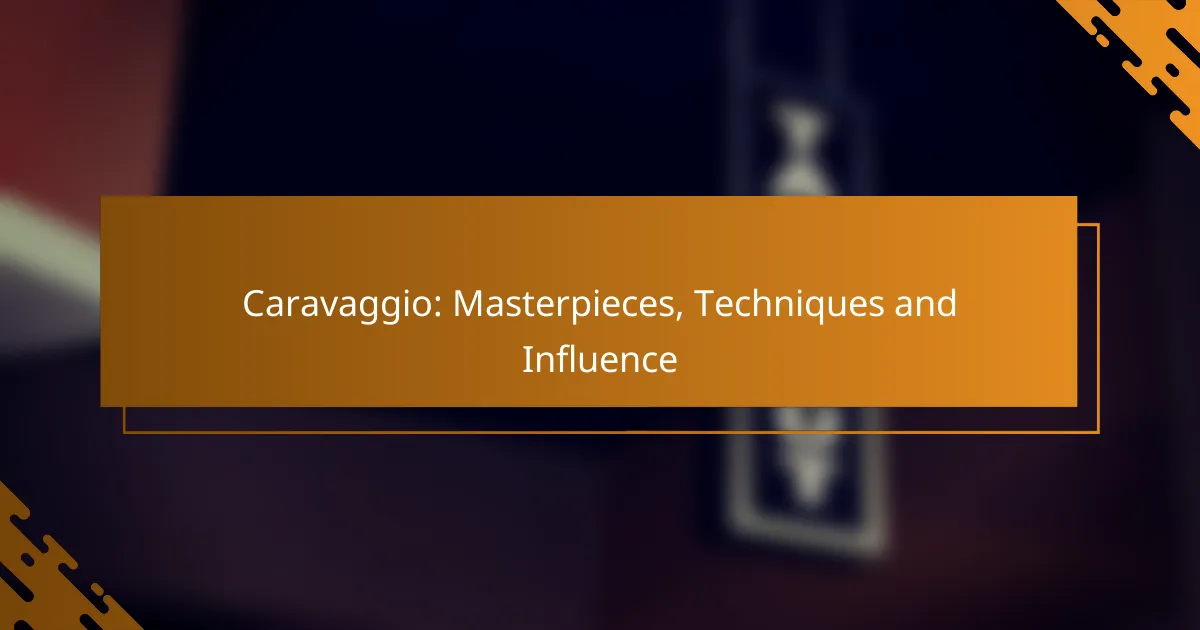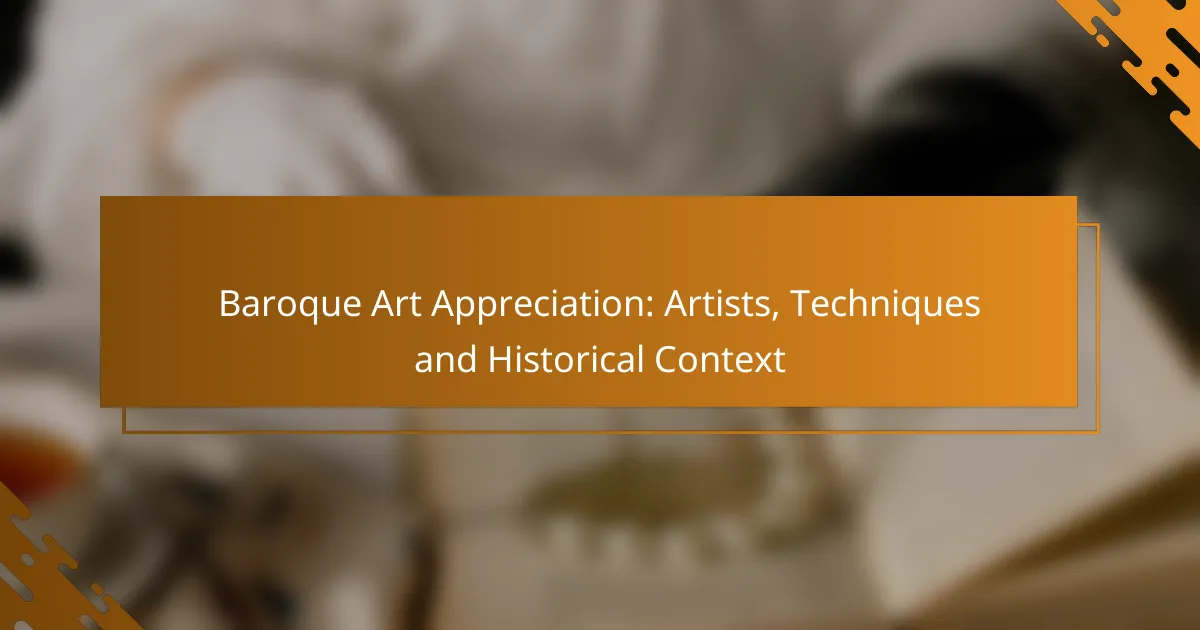The Baroque period, emerging in the late 16th century, is marked by its emotional depth and dramatic contrasts, captivating audiences with its powerful visual storytelling. Influential artists such as Caravaggio, Peter Paul Rubens, and Rembrandt van Rijn employed innovative techniques and a masterful use of light and shadow, leaving a lasting impact on the art world. Their ability to evoke strong emotions and convey complex narratives continues to resonate in modern artistic practices.

Who are the most influential Baroque artists?
The most influential Baroque artists include Caravaggio, Peter Paul Rubens, Rembrandt van Rijn, Gian Lorenzo Bernini, and Artemisia Gentileschi. These artists significantly shaped the Baroque movement through their innovative techniques, dramatic use of light and shadow, and emotional depth in their works.
Caravaggio
Caravaggio is renowned for his realistic depiction of human figures and dramatic use of chiaroscuro, which emphasizes the contrast between light and shadow. His works often featured religious themes, portrayed with a raw intensity that brought biblical stories to life in a relatable manner.
His technique of using live models and natural light set a new standard for realism in painting. Notable works include “The Calling of Saint Matthew” and “Judith Beheading Holofernes,” which showcase his ability to convey emotion and narrative through composition and color.
Peter Paul Rubens
Peter Paul Rubens was a prolific painter known for his vibrant color palette and dynamic compositions. His works often depicted historical and mythological subjects, infused with a sense of movement and sensuality that became hallmarks of the Baroque style.
Rubens’ ability to blend different genres, such as portraiture and landscape, allowed him to create complex and engaging scenes. His famous pieces, like “The Descent from the Cross” and “The Garden of Love,” exemplify his mastery of form and emotional expression.
Rembrandt van Rijn
Rembrandt van Rijn is celebrated for his profound understanding of light and shadow, which he used to create depth and emotion in his portraits and historical scenes. His innovative approach to lighting, particularly in works like “The Night Watch,” transformed the way subjects were depicted in art.
His ability to capture the human experience, with all its complexities, is evident in his self-portraits and biblical narratives. Rembrandt’s legacy lies in his exploration of human psychology and the use of texture and color to evoke feelings.
Gian Lorenzo Bernini
Gian Lorenzo Bernini was a master sculptor and architect whose work epitomized the Baroque style in three dimensions. His sculptures, such as “The Ecstasy of Saint Teresa,” are renowned for their dramatic expression and intricate details, bringing a sense of movement and life to stone.
As an architect, Bernini designed significant structures, including St. Peter’s Basilica’s colonnade in Vatican City, which embodies the grandeur of Baroque architecture. His ability to blend sculpture and architecture created immersive experiences that captivated viewers.
Artemisia Gentileschi
Artemisia Gentileschi was a pioneering female artist of the Baroque period, known for her powerful depictions of women from mythology and the Bible. Her works often conveyed themes of female strength and resilience, challenging the norms of her time.
Gentileschi’s notable paintings, such as “Judith Slaying Holofernes,” showcase her skill in dramatic storytelling and her mastery of light and shadow. Her contributions have gained recognition in recent years, highlighting her role in the Baroque movement and the art world at large.

What are the defining characteristics of Baroque art?
Baroque art is characterized by its emotional depth, dramatic contrasts, and a sense of movement. This style emerged in the late 16th century and is known for its ability to evoke strong feelings through visual storytelling.
Emotional intensity
Emotional intensity in Baroque art is achieved through the portrayal of dramatic scenes and expressive figures. Artists often depicted moments of high tension or deep spirituality, inviting viewers to connect with the emotions of the subjects.
For example, works like Caravaggio’s “The Calling of Saint Matthew” showcase intense facial expressions and body language, drawing the audience into the narrative. This focus on emotion was a departure from the more restrained expressions of the Renaissance.
Dramatic use of light and shadow
The dramatic use of light and shadow, known as chiaroscuro, is a hallmark of Baroque art. Artists skillfully manipulated light to create depth and highlight key elements within their compositions.
For instance, Rembrandt’s paintings often feature stark contrasts between illuminated figures and dark backgrounds, enhancing the emotional impact. This technique not only adds a three-dimensional quality but also guides the viewer’s eye to focal points in the artwork.
Movement and energy
Baroque art conveys a sense of movement and energy through dynamic compositions and swirling forms. Artists often arranged figures in diagonal lines or used swirling drapery to create a feeling of action.
A prime example is Gian Lorenzo Bernini’s sculpture “The Ecstasy of Saint Teresa,” which captures a moment of spiritual rapture with flowing garments and expressive poses. This sense of movement engages viewers and brings the artwork to life.
Rich color palette
The rich color palette of Baroque art contributes to its visual impact and emotional resonance. Artists employed deep, saturated colors to evoke mood and drama, often using contrasting hues to enhance the overall composition.
For example, Titian’s use of vibrant reds and golds in his paintings creates a sense of warmth and richness. This approach to color not only captivates the viewer but also reinforces the themes and emotions conveyed in the artwork.

How did Baroque artists influence modern art?
Baroque artists significantly influenced modern art through their innovative techniques, emotional depth, and dramatic use of light and shadow. Their emphasis on realism and storytelling continues to resonate in contemporary artistic practices, shaping how artists express complex narratives and emotions.
Techniques adopted by contemporary artists
Contemporary artists frequently adopt Baroque techniques such as chiaroscuro, which uses strong contrasts between light and dark to create a sense of volume and depth. This method enhances the emotional impact of their work, making it more engaging for viewers.
Additionally, the dynamic compositions seen in Baroque art inspire modern artists to create more fluid and energetic arrangements in their pieces. Techniques like foreshortening and dramatic perspective are often employed to draw the viewer’s eye and create a sense of movement.
Impact on visual storytelling
Baroque art’s focus on narrative and emotional expression has profoundly influenced visual storytelling in modern art. Artists today often incorporate dramatic scenes and character-driven narratives, similar to the storytelling techniques used by Baroque masters.
This influence is evident in graphic novels and illustrations, where artists utilize Baroque-inspired compositions to convey complex stories and emotions. The emphasis on dramatic tension and character interaction helps to create a more immersive experience for the audience.
Legacy in film and photography
The legacy of Baroque art is also prominent in film and photography, where lighting and composition play crucial roles in storytelling. Filmmakers often draw on Baroque principles to create visually striking scenes that evoke strong emotions, using techniques like chiaroscuro to enhance mood and atmosphere.
In photography, the dramatic use of light and shadow, along with carefully composed scenes, reflects Baroque influences. Photographers may emulate the theatricality of Baroque paintings to create compelling images that tell a story or evoke a specific feeling, demonstrating the enduring impact of this artistic movement.

What are notable Baroque art styles and movements?
Baroque art encompasses various styles and movements characterized by dramatic expression, rich detail, and a sense of movement. Notable styles include Italian, Flemish, and Spanish Baroque, each with distinct features and cultural influences.
Italian Baroque
Italian Baroque art is known for its grandeur and emotional intensity, often featuring dynamic compositions and dramatic lighting. Artists like Caravaggio and Gian Lorenzo Bernini played pivotal roles, using techniques such as chiaroscuro to enhance the emotional impact of their works.
Common themes in Italian Baroque include religious fervor and mythological subjects, often depicted with a sense of movement and realism. The use of bold colors and intricate details creates a captivating visual experience that draws viewers into the narrative.
Flemish Baroque
Flemish Baroque art is distinguished by its vibrant color palette and meticulous attention to detail, particularly in still life and genre scenes. Artists such as Peter Paul Rubens and Anthony van Dyck excelled in portraying rich textures and dynamic figures, often infused with a sense of movement.
This style often reflects the prosperity of the region during the 17th century, with artworks showcasing opulence and a celebration of everyday life. The interplay of light and shadow, along with intricate backgrounds, enhances the overall richness of Flemish Baroque paintings.
Spanish Baroque
Spanish Baroque art is marked by its dramatic use of light and shadow, often conveying deep emotional and spiritual themes. Artists like Diego Velázquez and Francisco de Zurbarán focused on realism and the human condition, using their works to explore complex narratives and religious devotion.
Key characteristics include a somber color palette and a focus on the psychological depth of subjects. Spanish Baroque often emphasizes the contrast between light and dark, creating a powerful atmosphere that invites reflection on the themes of life and faith.



